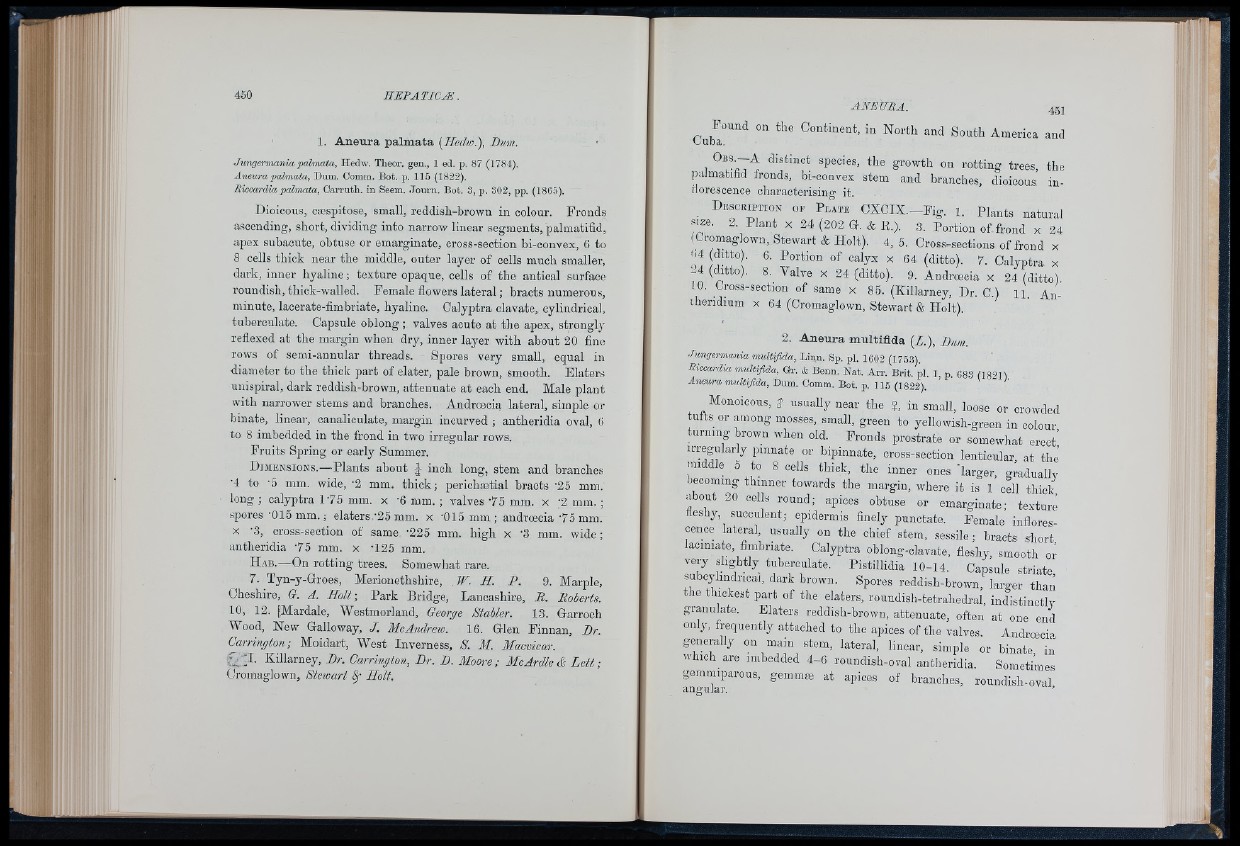
1. Aneura palmata [Iledw.), Dum.
Jungermaniapahnata, Hedw. Theor. gen., 1 ed. p. 87 (1784).
Aneura palmata, Dum. Comm. Bot. p. 1 1 5 (1822).
Riccardia palmata, Carruth. in Seem. Journ. Bot. 3, p. 302, pp. (1805).
Dioicous, cæspitose, small, reddish-brown in colour. Fronds
ascending, short, dividing into narrow linear segments, palmatifid,
apex subaoute, obtuse or emarginate, cross-seotion bi-oonvex, 6 to
8 cells thick near the middle, outer layer of cells much smaller,
dark, inner hyaline ; texture opaque, cells of the antioal surface
roundish, thick-walled. Female flowers lateral ; braots numerous,
minute, lacerate-fimbriate, hyaline. Calyptra clavate, cylindrical,
tuberculate. Capsule oblong ; valves acute at the apex, strongly
reflexed at the margin when dry, inner layer with about 20 fine
rows of semi-annular threads. Spores very small, equal in
diameter to the thick part of elater, pale brown, smooth. Elaters
unispiral, dark reddish-brown, attenuate at each end. Male plant
with narrower stems and branches. Androeoia lateral, simple or
binate, linear, canaliculate, margin incurved ; antheridia oval, G
to 8 imbedded in the frond in two irregular rows.
Fruits Spring or early Summer.
D imensions.—P la n ts ab o u t g in ch long, stem an d branches
•4 to A mm. wide, '2 mm. th ic k ; p e rio hæ tial b ra cts '25 mm.
long ; c a ly p tra 1 7 5 mm. x '6 mm. ; valves 7 5 mm. x '2 mm. ;
spores '015 mm. ; elaters '25 mm. x '015 mm ; andrcecia '75 mm.
x '3, oross-section of same '2 2 5 mm. h ig h x '3 mm. w id e ;
a n th e rid ia '75 mm. x T 2 5 mm.
H a b .— On rotting trees. Somewhat rare.
7. Tyn-y-Groes, Merionethshire, W. II. P. 9. Marple,
Cheshire, G. A. Holt; Park Bridge, Lancashire, B. Boberts.
10, 12. ¡Mardale, Westmorland, Georye Stabler. 13. Garroch
Wood, New Galloway, J. McAndrew. 16. Glen Pinnan, Dr.
Carrinyton; Moidart, West Inverness, 8. M. Macvicar.
'L Killarney, Dr. Carrinyton, Dr. D. Moore; McArdle & Lett ;
Cromaglown, Stewart fl Holt.
Pound on the Continent, in North and South America and
Duba,
I ^™'Hh on rotting trees, the
palmatifid frond.?, bi-convex stem and branches, dioicous inflorescence
characterising it.
D escription oe P late CX C IX .-F ig . 1. Plants natural
size. 2. Plant x 24 (202 G. & R.). 3. Portion of frond x 24
(Cromaglown, Stewart & Holt). 4, 5. Cross-sections of frond x
ditto). 6. Portion of calyx x 64 (ditto). 7. Calyptra x
24 (dutto). 8. Valve x 24 (ditto). 9. Andrcecia x 24 (ditto)
10. Cross-section of same x 85. (Killarney, Dr. C.) 11. Antheridium
X 64 (Cromaglown, Stewart & Holt).
2. Aneura multifida ( / .) , Dum.
■Tungermania multifida, Linn. Sp. pi. 1602 (1753).
Riccardia multifida, Gr. k Benn. Nat. A rr. Brit. pi. 1, p. 683 (18211.
Aneura multifida, Dum. Comm. Bot. p. 1 15 (1822).
Monoicous, / usually near the ?, in small, loose or crowded
tutts or among mosses, small, green to yellowish-green in colour
turning brown when old. Fronds prostrate or somewhat erect!
iriegulaily pinnate or bipinnate, cross-section lenticular, at the
middle 5 to 8 cells thick, the inner ones 'larger, gradually
becoming thinner towards the margin, where it is 1 cell thick,
about 20 cells round; apices obtuse or emarginate; texture
fleshy succulent; epidermis finely punctate. Female inflorescence
lateral usually on the chief stem, sessile; bracts short
laciniate, iimbnate. Calyptra oblong-clavate, fleshy, smooth oi-
very slightly tuberculate. Pistillidia 10-14. Capsule striate,
subcjlindrical, dark brown. Spores reddish-brown, larger than
the thickest part of the elaters, roundish-tetrahedral, indistinctly
granulate. Elaters reddish-brown, attenuate, often at one end
only, frequently attached to the apices of the valves. Andrcecia
generally on mam stem, lateral, linear, simple or binate in
which are imbedded 4-6 roundish-oval antheridia. Sometimes
gemmiparous, gemmæ at apices of branohes, roundish-oval
angular. ’